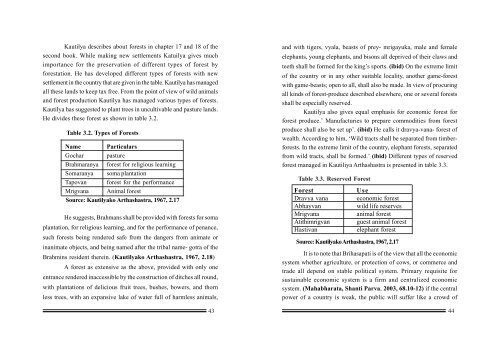Economics of Kautiliya Shukra and Brihaspati.pmd
Economics of Kautiliya Shukra and Brihaspati.pmd
Economics of Kautiliya Shukra and Brihaspati.pmd
You also want an ePaper? Increase the reach of your titles
YUMPU automatically turns print PDFs into web optimized ePapers that Google loves.
Kautilya describes about forests in chapter 17 <strong>and</strong> 18 <strong>of</strong> the<br />
second book. While making new settlements Katuilya gives much<br />
importance for the preservation <strong>of</strong> different types <strong>of</strong> forest by<br />
forestation. He has developed different types <strong>of</strong> forests with new<br />
settlement in the country that are given in the table. Kautilya has managed<br />
all these l<strong>and</strong>s to keep tax free. From the point <strong>of</strong> view <strong>of</strong> wild animals<br />
<strong>and</strong> forest production Kautilya has managed various types <strong>of</strong> forests.<br />
Kautilya has suggested to plant trees in uncultivable <strong>and</strong> pasture l<strong>and</strong>s.<br />
He divides these forest as shown in table 3.2.<br />
Table 3.2. Types <strong>of</strong> Forests<br />
Name Particulars<br />
Gochar pasture<br />
Brahmaranya forest for religious learning<br />
Somaranya soma plantation<br />
Tapovan forest for the performance<br />
Mrigvana Animal forest<br />
Source: Kautilyako Arthashastra, 1967, 2.17<br />
He suggests, Brahmans shall be provided with forests for soma<br />
plantation, for religious learning, <strong>and</strong> for the performance <strong>of</strong> penance,<br />
such forests being rendered safe from the dangers from animate or<br />
inanimate objects, <strong>and</strong> being named after the tribal name- gotra <strong>of</strong> the<br />
Brahmins resident therein. (Kautilyako Arthashastra, 1967, 2.18)<br />
A forest as extensive as the above, provided with only one<br />
entrance rendered inaccessible by the construction <strong>of</strong> ditches all round,<br />
with plantations <strong>of</strong> delicious fruit trees, bushes, bowers, <strong>and</strong> thorn<br />
less trees, with an expansive lake <strong>of</strong> water full <strong>of</strong> harmless animals,<br />
43<br />
<strong>and</strong> with tigers, vyala, beasts <strong>of</strong> prey- mrigayuka, male <strong>and</strong> female<br />
elephants, young elephants, <strong>and</strong> bisons all deprived <strong>of</strong> their claws <strong>and</strong><br />
teeth shall be formed for the king’s sports. (ibid) On the extreme limit<br />
<strong>of</strong> the country or in any other suitable locality, another game-forest<br />
with game-beasts; open to all, shall also be made. In view <strong>of</strong> procuring<br />
all kinds <strong>of</strong> forest-produce described elsewhere, one or several forests<br />
shall be especially reserved.<br />
Kautilya also gives equal emphasis for economic forest for<br />
forest produce.’ Manufacturies to prepare commodities from forest<br />
produce shall also be set up’. (ibid) He calls it dravya-vana- forest <strong>of</strong><br />
wealth. According to him, ‘Wild tracts shall be separated from timberforests.<br />
In the extreme limit <strong>of</strong> the country, elephant forests, separated<br />
from wild tracts, shall be formed.’ (ibid) Different types <strong>of</strong> reserved<br />
forest managed in <strong>Kautiliya</strong> Arthashastra is presented in table 3.3.<br />
Table 3.3. Reserved Forest<br />
Forest Use<br />
Dravya vana economic forest<br />
Abhayvan wild life reserves<br />
Mrigvana animal forest<br />
Atithimrigvan guest animal forest<br />
Hastivan elephant forest<br />
Source: Kautilyako Arthashastra, 1967, 2.17<br />
It is to note that Brihasapati is <strong>of</strong> the view that all the economic<br />
system whether agriculture, or protection <strong>of</strong> cows, or commerce <strong>and</strong><br />
trade all depend on stable political system. Primary requisite for<br />
sustainable economic system is a firm <strong>and</strong> centralized economic<br />
system. (Mahabharata, Shanti Parva, 2003, 68.10-12) if the central<br />
power <strong>of</strong> a country is weak, the public will suffer like a crowd <strong>of</strong><br />
44


